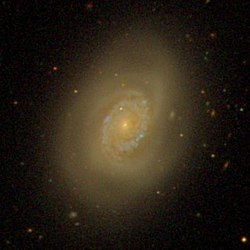| NGC 4580 | |
|---|---|
 SDSS image of NGC 4580 | |
| Observation data (J2000 epoch) | |
| Constellation | Virgo |
| Right ascension | 12h 37m 48.4s[1] |
| Declination | 05° 22′ 07″[1] |
| Redshift | 0.003449[1] |
| Heliocentric radial velocity | 1034 km/s[1] |
| Distance | 69.35 Mly (21.263 Mpc)[1] |
| Group or cluster | Virgo Cluster |
| Apparent magnitude (V) | 12.7[1] |
| Characteristics | |
| Type | SAB(rs)a pec, LINER[1] |
| Size | ~52,400 ly (16.08 kpc) (estimated)[1] |
| Apparent size (V) | 2.28 x 1.45[1] |
| Other designations | |
| CGCG 42-183, IRAS 12352+0538, MCG 1-32-117, PGC 42174, UGC 7794, VCC 1730[1] | |
NGC 4580 is an unbarred spiral galaxy[2] located about 70 million light-years away[3] in the constellation Virgo.[4] NGC 4580 is also classified as a LINER galaxy.[3][5] It was discovered by astronomer William Herschel on February 2, 1786[6] and is a member of the Virgo Cluster.[2][7]
Physical characteristics
[edit]NGC 4580 consists of a ringed structure. The inner pseudoring of the galaxy is very well-defined and is made of two tightly wound spiral arms. Three very diffuse spiral arms which are partly defined by dust, split off from the inner pseudoring.[2]
Truncated disk
[edit]NGC 4580 has a severely truncated star-forming disk. This may be due to ram-pressure stripping[2] caused by the infall of the Messier 49 subcluster into the Virgo Cluster.[8] Due to the truncation of the star forming disk, NGC 4580 is classified as an anemic galaxy.[9]
See also
[edit]References
[edit]- ^ a b c d e f g h i j "NASA/IPAC Extragalactic Database". Results for NGC 4580. Retrieved 2018-02-24.
- ^ a b c d "NGC 4580 - SA(rs)ab". The de Vaucouleurs Atlas of Galaxies. Retrieved 2018-02-24.
- ^ a b "Your NED Search Results". ned.ipac.caltech.edu. Retrieved 2018-02-24.
- ^ "Revised NGC Data for NGC 4580". spider.seds.org. Retrieved 2018-02-24.
- ^ "NGC4580". Retrieved 2018-02-24.
- ^ "New General Catalog Objects: NGC 4550 - 4599". cseligman.com. Retrieved 2018-02-24.
- ^ "The Virgo Cluster". www.atlasoftheuniverse.com. Retrieved 2018-02-24.
- ^ Cortés, Juan R.; Kenney, Jeffrey D. P.; Hardy, Eduardo (2008). "Distances from Stellar Kinematics for Peculiar Virgo Cluster Spiral Galaxies". The Astrophysical Journal. 683 (1): 78. arXiv:0803.3638. Bibcode:2008ApJ...683...78C. doi:10.1086/588604. ISSN 0004-637X. S2CID 14426987.
- ^ Koopmann, Rebecca A.; Kenney, Jeffrey D. P. (2004). "Hα Morphologies and Environmental Effects in Virgo Cluster Spiral Galaxies". The Astrophysical Journal. 613 (2): 866–885. arXiv:astro-ph/0406243. Bibcode:2004ApJ...613..866K. doi:10.1086/423191. ISSN 0004-637X. S2CID 17519217.
External links
[edit]- NGC 4580 on WikiSky: DSS2, SDSS, GALEX, IRAS, Hydrogen α, X-Ray, Astrophoto, Sky Map, Articles and images
Well, that’s interesting to know that Psilotum nudum are known as whisk ferns. Psilotum nudum is the commoner species of the two. While the P. flaccidum is a rare species and is found in the tropical islands. Both the species are usually epiphytic in habit and grow upon tree ferns. These species may also be terrestrial and grow in humus or in the crevices of the rocks.
View the detailed Guide of Psilotum nudum: Detailed Study Of Psilotum Nudum (Whisk Fern), Classification, Anatomy, Reproduction